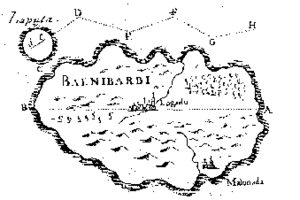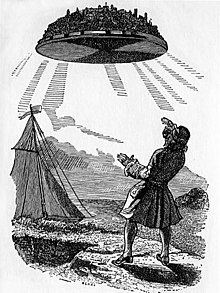| Revision as of 23:24, 22 May 2024 editToughpigs (talk | contribs)Extended confirmed users73,009 edits add reference to book of critical essays← Previous edit | Revision as of 23:25, 22 May 2024 edit undoToughpigs (talk | contribs)Extended confirmed users73,009 edits →Legacy: not an important exampleNext edit → | ||
| Line 59: | Line 59: | ||
| The 1986 Japanese ] fantasy film, '']'', directed by ], derives its name and basic premise from Swift's novel. | The 1986 Japanese ] fantasy film, '']'', directed by ], derives its name and basic premise from Swift's novel. | ||
| The British indie rock band ] included a song named "Laputa" on their album '']'' released in 2000. | |||
| == Explanatory notes == | == Explanatory notes == | ||
Revision as of 23:25, 22 May 2024
Fictional flying island For other uses, see Laputa (disambiguation).| An editor has nominated this article for deletion. You are welcome to participate in the deletion discussion, which will decide whether or not to retain it.Feel free to improve the article, but do not remove this notice before the discussion is closed. For more information, see the guide to deletion. Find sources: "Laputa" – news · newspapers · books · scholar · JSTOR%5B%5BWikipedia%3AArticles+for+deletion%2FLaputa%5D%5DAFD |
| The topic of this article may not meet Misplaced Pages's general notability guideline. Please help to demonstrate the notability of the topic by citing reliable secondary sources that are independent of the topic and provide significant coverage of it beyond a mere trivial mention. If notability cannot be shown, the article is likely to be merged, redirected, or deleted. Find sources: "Laputa" – news · newspapers · books · scholar · JSTOR (May 2024) (Learn how and when to remove this message) |
| This article only references primary sources. Please help improve this article by adding secondary or tertiary sources. Find sources: "Laputa" – news · newspapers · books · scholar · JSTOR (May 2024) (Learn how and when to remove this message) |
| Laputa | |
|---|---|
| Gulliver's Travels location | |
 Map of Laputa and Balnibarbi (original map, Pt III, Gulliver's Travels) Map of Laputa and Balnibarbi (original map, Pt III, Gulliver's Travels) | |
| Created by | Jonathan Swift |
| Genre | Satire |
| In-universe information | |
| Type | Flying island |
| Characters | King |

Laputa /ləˈpuːtə/ is a flying island described in the 1726 book Gulliver's Travels by Jonathan Swift. It is about 4+1⁄2 miles (7 kilometres) in diameter, with an adamantine base, which its inhabitants can manoeuvre in any direction using magnetic levitation. The island is the home of the king of Balnibarbi and his court, and is used by the king to enforce his rule over the lands below.
Location
Laputa was located above the realm of Balnibarbi, which was ruled by its king from the flying island. Gulliver states the island flew by the “magnetic virtue” of certain minerals in the grounds of Balnibarbi which did not extend to more than 4 miles (6.5 kilometres) above, and six leagues (29 kilometres) beyond the extent of the kingdom, showing the limit of its range. The position of the island, and the realm below, is some five days' journey south-south-east of Gulliver's last known position, 46° N, 183° E (i.e. east of Japan, south of the Aleutian Islands) down a chain of small rocky islands.
Description
The island of Laputa is described as being exactly circular and about 4+1⁄2 miles (7 kilometres) in diameter, giving an area of roughly 10,000 acres (4,000 hectares). The island was 300 yards (270 metres) thick, and comprised a bottom plate of adamant 200 yards (180 metres) thick, above which lay "the several minerals in their usual order", topped with "a coat of rich mould 10 or 12 ft deep".
In shape the upper surface sloped down from circumference to centre, causing all rain to form rivulets into the centre where four large basins 1⁄2 mile (800 metres) in circuit lie 200 yards (180 metres) from the absolute centre. In the centre of the island itself was a chasm 50 yards in diameter continuing down into a dome extending 100 yards (91 metres) into the adamantine surface. This dome served as an astronomical observatory, and also contained the lodestone which enabled the island to fly and move above the realm.
Inhabitants

Laputa's population consists mainly of an educated elite, who are fond of mathematics, astronomy, music and technology, but fail to make practical use of their knowledge. Servants make up the rest of the population.
The Laputans have mastered magnetic levitation. They also are very fond of astronomy, and discovered two moons of Mars. (This is 151 years earlier than the recognized discovery of the two moons of Mars by Asaph Hall in 1877.) However, they are unable to construct well-designed clothing or buildings, as they despise practical geometry as "vulgar and mechanick". The houses are ill-built, lacking any right angles, and the clothes of Laputans, which are decorated with astrological symbols and musical figures, do not fit, as they take measurements with instruments such as quadrants and a compass rather than with tape measures. They spend their time listening to the music of the spheres. They believe in astrology and worry constantly that the sun will go out.
Many of them have heads angled to one side, and they often suffer from strabismus: one eye turns inward and the other looks up "to the zenith", conditions that Swift uses to mock the microscope and the telescope. Laputans are described as becoming so lost in thought that they cannot focus their attention on a conversation or avoid running into a tree or falling into a ditch unless periodically struck by a bladder full of pebbles or dry peas carried by one or two "flappers" or, in their native language, "climenoles", hired for the purpose.
Laputa is a male-dominated society. Wives often request to leave the island to visit the land below; however, these requests are almost never granted because the women who leave Laputa never want to return. The Laputan women are highly sexed (having "an abundance of vivacity") and adulterous, and, whenever possible, take on lovers out of visitors from the lands below. The Laputan husbands, who are so abstracted in mathematical and musical calculations, might assume their wives are adulterous, but so long as they have no flapper around, they won't notice the adultery even should it occur right before their eyes.
Nearby lands
The land beneath the floating island, within the region the Laputa can travel, is known as Balnibarbi. Balnibarbi is controlled by the king of Laputa; its ground capital is the city of Lagado.
Laputa's king is able to control the mainland mostly by threatening to cover rebel regions with the island's shadow, thus blocking sunlight and rain, or by throwing rocks at rebellious surface cities. In extreme cases, the island is lowered onto the cities below to crush them, although this is not successful every time, notably in the case of Lindalino.
The Balnibarbian language, spoken on both Laputa and Balnibarbi, is described by Gulliver as sounding similar to Italian.
Symbolism
Lindalino's relationship with Laputa was intended as an allegory of Ireland's relationship with England, and the Whig government's foreign and internal politics (as Jonathan Swift was a Tory). The Laputans' absurd inventions mock the Royal Society. As "la puta" means "the whore" in Spanish, some Spanish editions of Gulliver's Travels use "Lapuntu", "Laput", "Lapuda" and "Lupata" as bowdlerisations. It is likely, given Swift's education and satirical style, that he was aware of the Spanish meaning. (Gulliver claimed Spanish among the many languages in which he was fluent.)
Legacy
On Mars's largest moon, Phobos, there is a feature named regio, Laputa Regio, which is named after Swift's Laputa because of his 'prediction' of the two then undiscovered Martian moons, which his Laputan astronomers had discovered.
The 1986 Japanese animated fantasy film, Laputa: Castle in the Sky, directed by Hayao Miyazaki, derives its name and basic premise from Swift's novel.
Explanatory notes
- That is, 177° W.
- The text actually says "...its Diameter 7837 Yards or about four Miles and a Half, and consequently contains Ten Thousand Acres" (Gulliver;'s Travels Pt III, Ch III): However, neither of these diameters gives an area of exactly 10,000 acres. It is unclear why Swift chose such exact values for diameter and area, while having them misalign in this way.
Citations
- Williams, Kathleen (1968). "Gulliver in Laputa". In Brady, Frank (ed.). Twentieth Century Interpretations of Gulliver's Travels: A Collection of Critical Essays. Prentice-Hall. pp. 60 & ff. ISBN 9780133715675. Retrieved 22 May 2024.
- Swift 2008, p. 157.
- ^ Swift 2008, p. 143.
- Swift 2008, p. 319.
- ^ Swift 2008, p. 154.
- Swift 2008, p. 155.
- Swift 2008, p. 151.
- Swift 2008, p. 150.
- Swift 2008, p. 148.
- Swift 2008, p. 153.
- Swift 2008, p. 159.
- Swift, Jonathan (1900). Gulliver's Travels into Several Remote Regions of the World. Boston; New York; Chicago: D.C. Heath & Co., Publishers. Part I, Chapter II.
- Gazetteer of Planetary Nomenclature USGS Astrogeology Research Program, Phobos
General sources
- Page, Michael; Ingpen, Robert (1998). Encyclopedia of Things That Never Were. New York: Penguin Studio. pp. 94, 150–1. ISBN 0-14-010008-3.
- Swift, Jonathan (2008) . Gulliver's Travels. Oxford World Classics. introduction by Claude Rawson, explanatory notes by Ian Higgins (reprint ed.). First published 1726.
External links
| Jonathan Swift's Gulliver's Travels (1726) | |
|---|---|
| Characters | |
| Locations | |
| Other characters | |
| Films |
|
| Television |
|
| Related | |